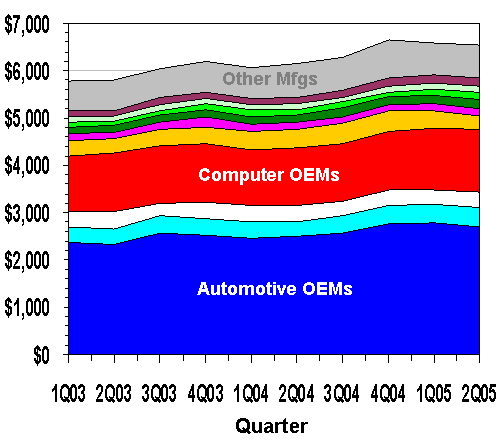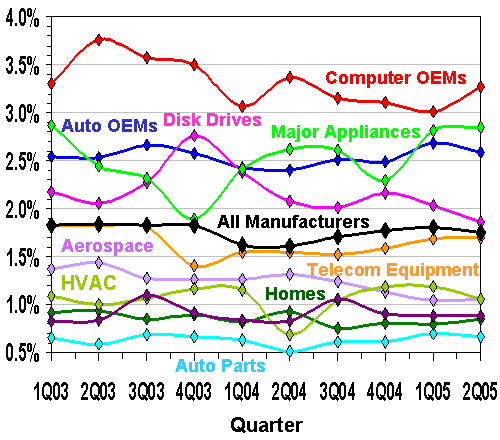Warranty Claims by Industry:
Over the past ten quarters, warranty claims patterns have remained remarkably consistent in numerous industries. Those closest to consumers in the supply chain seem to experience the highest claims rates.
Warranty claims as measured both in dollars spent and as a percentage of product sales are proving to be remarkably consistent and predictable over time, based upon a look at ten quarters' worth of data.
It's not that any one company is all that consistent. Very few are. In fact there's always a couple of shocks among the 800 or so U.S.-based manufacturers who now report their warranty claims and accruals in their financial statements. But when several close competitors are grouped together into an industry, their aggregate spending curves flatten out to a large degree, whether one is counting warranty expenditures in raw dollars or as a percentage of sales.
Our HTML email subscribers will see two charts below that illustrate these trends. Our plain text email subscribers will see the raw data in table form. Both groups are welcome to take a look in the newsletter archive on the Web site at http://www.warrantyweek.com/newsarchive/ww20050907.html, where both charts and tables will be available.
In Figure 1 below, warranty spending in ten different industries is tracked over ten quarters. We're actually organizing warranty providers into 14 or 15 different industries, but for this exercise we combined several of the smaller segments into the "other" category.
Figure 1
Warranty Claims per Quarter
by Industry
1Q 2003 to 2Q 2005
(in $ millions)

Source: Warranty Week from SEC data
| Industry | 1Q03 | 2Q03 | 3Q03 | 4Q03 | 1Q04 | 2Q04 | 3Q04 | 4Q04 | 1Q05 | 2Q05 |
|---|---|---|---|---|---|---|---|---|---|---|
| Auto OEM | $2,366 | $2,320 | $2,563 | $2,531 | $2,467 | $2,504 | $2,566 | $2,764 | $2,792 | $2,704 |
| Auto Parts | $333 | $330 | $377 | $337 | $344 | $302 | $359 | $386 | $374 | $413 |
| Aerospace | $319 | $366 | $258 | $351 | $331 | $346 | $308 | $328 | $305 | $324 |
| Computer | $1,178 | $1,242 | $1,211 | $1,239 | $1,193 | $1,218 | $1,226 | $1,233 | $1,307 | $1,311 |
| Telecom | $326 | $308 | $342 | $357 | $388 | $395 | $425 | $436 | $381 | $303 |
| Disk Drive | $148 | $139 | $156 | $209 | $157 | $147 | $142 | $144 | $149 | $139 |
| New Homes | $125 | $136 | $150 | $158 | $150 | $149 | $189 | $177 | $179 | $202 |
| Appliances | $124 | $93 | $103 | $116 | $134 | $119 | $123 | $85 | $133 | $149 |
| HVAC | $98 | $98 | $112 | $110 | $114 | $123 | $103 | $126 | $129 | $135 |
| Medical | $131 | $130 | $153 | $142 | $146 | $141 | $147 | $172 | $154 | $177 |
| Other | $632 | $651 | $608 | $653 | $640 | $700 | $686 | $792 | $684 | $693 |
| Total | $5,782 | $5,814 | $6,034 | $6,202 | $6,064 | $6,145 | $6,274 | $6,642 | $6,587 | $6,548 |
What immediately jumps out from this chart is the relative weight of the computer OEM and the automotive OEM categories. Indeed, computer OEMs such as Hewlett-Packard, Dell, and IBM account for 20% to 21% of the overall total spending seen for all U.S.-based manufacturers worldwide. Back in the second quarter of 2003, they accounted for 21% of $5.8 billion. In the second quarter of 2004, their share was 20% of $6.1 billion. And in the second quarter of 2005 -- the latest for which statistics are available -- their share was 20% of an estimated $6.6 billion.
Steady Share for Auto OEMs
Automotive OEMs, meanwhile, have seen their share of warranty claims oscillate all the way from 40% to 42%. Auto OEMs reported $2.3 billion in claims during the second quarter of 2003; $2.5 billion in the second quarter of 2004; and $2.7 billion in the second quarter of 2005. So as the chart suggests, both types of OEMs are seeing their warranty claims totals grow more or less at the industry average rate.
One note of caution, however: because we are still awaiting the annual reports of some manufacturers whose fiscal years ended June 30, and because several other manufacturers detail their warranty spending only once a year, we have inserted several estimates into the mix. In addition, because of accounting problems, several companies are now a few quarters behind in their financial filings. Eventually, when the actual data arrives, we will revise the totals up or down, as appropriate. Right now, we're guessing what they're spending on warranty in 2005 based on eight or nine previous quarters of data.
In other words, we're estimating that U.S.-based manufacturers spent $6.55 billion on claims and made $7.65 billion in accruals during the second quarter of 2005. However, the estimates we've inserted for just the top ten missing warranty providers -- Applera, Black & Decker, Briggs & Stratton, Eaton, General Electric, Motorola, Sun Microsystems, Terex, Textron, and Western Digital -- is well over $400 million. So don't take these figures as the final word. As of September 7, 2005, it's only 93% of the final word and 7% extrapolation.
Also, because diversified manufacturers do not break out warranty spending by division or by product line, all manufacturers were placed in one and only one category based upon their dominant revenue stream. For instance, United Technologies is counted within aerospace alone, which somewhat undercounts the HVAC sector in which their Carrier unit dominates. Honeywell and Textron are also in the aerospace category, which overlooks their respective presence in electronics and small vehicles. Were we to move these three to other categories, the tally for aerospace warranties would be reduced by 60%.
Color Coded Industries
In the chart above, automotive parts suppliers are color coded light blue. Depending upon the quarter, they account for between 4.9% and 6.3% of the overall total. Auto OEMs are dark blue and computer OEMs are in red. Disk drive manufacturers are coded pink, and telecom equipment manufacturers are coded orange. New home warranties are coded dark green; major appliances are coded bright green; and heating, ventilation and air conditioning warranties are coded olive green. Aerospace is coded light purple and medical equipment is coded dark purple. Each of those industries has a share between 2% and 5% of the total, which makes them both hard to see and difficult to label individually.
Labels were more successfully applied in Figure 2 below. The color codes are the same as above, but in Figure 2 the vertical scale is plotted in terms of the percentage of total industry product revenue that's spent on warranty claims. For instance, the computer OEMs spent $1.3 billion on claims during the second quarter of 2005, and this represented around 3.3% of their overall product sales. The auto OEMs spent just under 2.6% of their $104 billion in warranted auto product sales on warranty claims. Service, finance, investment, and other non-warranted revenue streams are subtracted from the industry totals whenever possible.
Figure 2
Warranty Claims Rates
by Industry
1Q 2003 to 2Q 2005
(as a % of product sales)

Source: Warranty Week from SEC data
| Industry | 1Q03 | 2Q03 | 3Q03 | 4Q03 | 1Q04 | 2Q04 | 3Q04 | 4Q04 | 1Q05 | 2Q05 |
|---|---|---|---|---|---|---|---|---|---|---|
| Auto OEM | 2.5% | 2.5% | 2.7% | 2.6% | 2.4% | 2.4% | 2.5% | 2.5% | 2.7% | 2.6% |
| Auto Parts | 0.7% | 0.6% | 0.7% | 0.7% | 0.6% | 0.5% | 0.6% | 0.6% | 0.7% | 0.7% |
| Aerospace | 1.4% | 1.4% | 1.3% | 1.3% | 1.3% | 1.3% | 1.2% | 1.1% | 1.0% | 1.0% |
| Computer | 3.3% | 3.8% | 3.6% | 3.5% | 3.1% | 3.4% | 3.2% | 3.1% | 3.0% | 3.3% |
| Telecom | 1.8% | 1.8% | 1.8% | 1.4% | 1.5% | 1.5% | 1.5% | 1.6% | 1.7% | 1.7% |
| Disk Drive | 2.2% | 2.0% | 2.3% | 2.8% | 2.4% | 2.1% | 2.0% | 2.2% | 2.0% | 1.9% |
| New Homes | 0.9% | 0.9% | 0.8% | 0.9% | 0.8% | 0.9% | 0.8% | 0.8% | 0.8% | 0.8% |
| Appliances | 2.9% | 2.4% | 2.3% | 1.9% | 2.4% | 2.6% | 2.6% | 2.3% | 2.8% | 2.9% |
| HVAC | 1.1% | 1.0% | 1.1% | 1.2% | 1.1% | 0.7% | 1.0% | 1.2% | 1.2% | 1.0% |
| Medical | 0.8% | 0.8% | 1.1% | 0.9% | 0.8% | 0.8% | 1.1% | 0.9% | 0.9% | 0.9% |
| Total | 1.8% | 1.8% | 1.8% | 1.8% | 1.6% | 1.6% | 1.7% | 1.8% | 1.8% | 1.7% |
Again, notice the position of the OEM lines, both red and blue. They're towards the top, suggesting higher-than-average warranty claims rates, as is the bright green line representing major appliance manufacturers such as Whirlpool and Maytag. In fact, if we labeled them as appliance OEMs, the trend becomes clear: manufacturers who face end users most directly will generally experience warranty at a higher rate than their suppliers. GM sees a 3% claims rate while Delphi sees a 0.6% rate. Whether because of processing inefficiencies or missed opportunities, the OEMs are generally left holding the bag. And that's as true for automakers as for computer assemblers and major appliance manufacturers.
Business-to-Business Sales
Also, manufacturers who sell primarily to consumers seem to experience higher warranty claims rates than those who sell to businesses who are themselves in the service business (hospitals, airlines, telephone companies, etc.), and who are buying and using the equipment to earn service revenue. This would seem to be counter-intuitive. After all, wouldn't airlines and telephone companies be tougher to please than homeowners and commuters? Yet even within the automotive category, recreational vehicles and light trucks throw off more claims than on-highway trucks or emergency vehicles. Within telecom equipment, Netgear's wireless LANs sold at retail have a 5% claims rate while Lucent's central office telco switches have a 1% claims rate.
Perhaps there's a correlation between the sophistication of the customer and the quality of the equipment? Or perhaps business customers do more testing and inspection at the outset, reducing the need for warranty work by spotting defective units before they're accepted, deployed or even paid for? One reader suggested that medical equipment and airplanes are simply too important to fail, compared to laptops or pickup trucks. Yet they do fail, albeit at a 1% rate instead of 3% or more. And at least within the airline industry, problematic units tend to get swapped out long before they can cause a catastrophic failure and possibly a loss of life. And for some medical equipment manufacturers, extended warranty sales are a steady source of profits. What hospital or doctor would buy an extended warranty on equipment that never fails?
Combining these two trends, we would suggest that OEMs who sell to consumers have the highest claims rates, and suppliers who sell to suppliers have the lowest claims rates. The industry labels don't themselves specify position within the supply chain, and in fact some categories such as HVAC contain a mixture of both OEMs and parts suppliers. But even there, looking at the raw data, it's clear that the end user-facing OEMs almost always have higher claims rates than their suppliers.
The exception to these rules seems to be the disk drive industry. However, in previous articles where we took apart computers and motor vehicles piece by piece, we found that both disk drives and engines/transmissions experience warranty at close to the OEM rate while almost every other category of parts supplier experiences warranty at radically lower rates. One could theorize that disk drives are something akin to the "powertrain" of a computer. Brakes, mufflers, lights, interiors, and glass are much like the circuit boards and fans inside a PC. So there's another theory: disk drive and drivetrain manufacturers generally have higher claims rates than their parts-making peers.
Where You Sit Is Where You Stand
What we're saying is that warranty claims rates depend somewhat on product type and somewhat on position within the supply chain. The GMs and the HPs of the world have much in common in terms of their position within the supply chain, even if their product lines are vastly different (although Hummer is now selling laptops, see headline at right). Seagate and ArvinMeritor are similar as are Cisco and Delphi. But perhaps there's no better example than Motorola, selling electronic, entertainment, and communications components to both Silicon Valley and Detroit, and seeing claims rates in the vicinity of 0.7% to 1.3%. We'd bet that the products Motorola sells to consumers have higher claims rates than those sold to businesses, and that those sold to businesses have similar claims rates, whether the customers are in the computer, telecom, or automotive industries.
The label for medical and scientific equipment just wouldn't fit in the chart. That's the dark purple line near the bottom. Finally, there's a black line towards the middle which represents all 800 or so manufacturers who report warranty expenses. As it shows, the weighted average claims rate for all manufacturers has fluctuated mostly between 1.7% and 1.8% over the past 10 quarters. This year it's remained close to the high end of that range at 1.75% to 1.8%. But it's never been higher than 1.84% and it's never been lower than 1.61%, at least not since warranty disclosures began in early 2003.
The flatter the lines look, the more reliable they may be as benchmarks for their respective industries. Therefore, because the dark blue, green, and purple lines are relatively flat, one could conclude that 2.5% is the typical claims rate for an auto OEM, and 1% is typical for new homes as well as for the medical and scientific equipment field. Individual warranty providers may oscillate around these industry averages, but their very flatness suggests that they are reliable measurements over time.
Seasonal Trends?
The lines that look more like foothills are coming from industries that are either seasonal by nature or are seeing one or more major players successfully cutting their warranty expense over time. In telecom equipment, for instance, Lucent has chopped its warranty claims rate from close to 4% to under 1%. In dollar terms, they've gone from $50 million to $20 million per quarter in claims. And that means Lucent alone has caused telecom equipment warranty spending to decline by close to 10% industry-wide. What at first looks like an industry-wide trend is in fact a trend for just one or two major players.
Over time, perhaps in another year or two, these oscillating sine waves also will flatten out, or at least by then we'll know their typical amplitude and frequency. It may never be possible to figure out the claims rate for something as specific as , say, toasters. But in time it will be possible to take a look at product type, warranty duration, and the seller's position within the supply chain and make a fairly accurate guess of what the normal range would be for their warranty claims rates.
| Back to Part Two | Go to Part Four |








